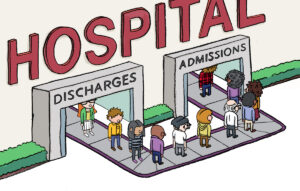Readmission Mitigation: A Summary
Prior editions of the 'Redefining Heart Failure Blog' ...
In the prior editions of the “Redefining Heart Failure” blog series, we’ve explored the context of readmission statistics, their relevance for understanding the cause of admission, measures to prevent it, and the proven strategies available.
If you would like to read them all before this part 5 on the mitigation measures, you can do so here:
Pt 1: The Current State of Heart Failure
Pt 2: Factors Increasing Readmission
Historical studies suggest that high-volume hospitals may have lower readmission rates for heart failure patients and the concentrations of highly specialised practitioners were the formula for readmission mitigation strategies. Recent studies, however, have shown the opposite relation – despite having proven to reduce surgery complications and hospital mortality, their readmission rates are higher. Supposing this is true across the spectrum of hospital facilities, it suggests readmission risks are associated with a different aspect of care than those driving in-hospital mortality or surgical complications. [1]
 Reducing readmissions through increased focus on patient education and post-discharge care planning are the most effective intervention measures to improve quality of life. There are many opportunities to mitigate the costs associated with readmission by taking preventative measures such as education or community-based programmes. Hence, it is critical that personalised education, follow-up, and treatment planning become part of the admission procedure. [2]
Reducing readmissions through increased focus on patient education and post-discharge care planning are the most effective intervention measures to improve quality of life. There are many opportunities to mitigate the costs associated with readmission by taking preventative measures such as education or community-based programmes. Hence, it is critical that personalised education, follow-up, and treatment planning become part of the admission procedure. [2]
Lifestyle factors such as self-care and monitoring levels of physical work performed by patients, guided by trained professionals, are critical steps in ensuring adherence to medical regimens. It is also clear from the literature that scheduling follow-up appointments before discharge and checking-in calls starting 24h after discharge significantly impact the short-term readmission rate. Teaching reinforcement and encouragement can be facilitated through home care programs or community support groups. For some patients, home monitoring devices can be a convenient way to track some of the rehospitalisation predictors. [3]
Future of Readmission Avoidance
Reducing heart failure patient readmissions to hospitals requires more than simply improving the traditional interventions. Patient education and monitoring throughout the admission, followed through their recovery by a qualified team, ensures that the after-care practices are followed. Adherence to these programs has shown a reduction in readmission rates or the ability to avoid admission through early referral to specialist care centres. Yet, these are often significantly resource-intensive and operate without actional status data or utilise cost-prohibitive technologies. [4]
Hospital avoidance programs set up in ambulatory settings are the last line of defence against readmission. They can help take the burden off the hospital by treating low-to-medium-risk patients with urgent care interventions such as rapid drug up-titration, new treatment initiation, intravenous diuretic delivery and ultrafiltration intervention. The success of this approach relies on the accurate classification of high and low-risk patients and is, therefore, a challenge in these ambulatory care settings. In the absence of empirical measures of congestion or functional status, highly specialised healthcare professionals are needed to ensure the success of these programmes, which increases the cost of delivery and limit the scalability of this as a viable solution. [5]
 A raft of point-of-care diagnostics has become available to better inform healthcare professionals on a patient’s biomarkers in Heart Failure, Similar to how rapid glucose monitors dramatically changed diabetes care. Intracardiac Pressure Monitoring (IPCM) technologies have set a new standard of patient classification beyond point-of-care technologies. Although invasive and high cost as a single-use device, patients with these technologies have advantages over other patient groups. IPCM provides early warnings to acute decompensation, which gains time to initiate preventive treatment changes. The current deployment of these technologies shows they are not deployed equitably or with a high enough penetration to affect the macro picture of rehospitalisation significantly. Furthermore, lower socioeconomic factors negatively impact patients’ access to these technologies despite increasing disease prevalence in lower socioeconomic and ethnic groups. [6]
A raft of point-of-care diagnostics has become available to better inform healthcare professionals on a patient’s biomarkers in Heart Failure, Similar to how rapid glucose monitors dramatically changed diabetes care. Intracardiac Pressure Monitoring (IPCM) technologies have set a new standard of patient classification beyond point-of-care technologies. Although invasive and high cost as a single-use device, patients with these technologies have advantages over other patient groups. IPCM provides early warnings to acute decompensation, which gains time to initiate preventive treatment changes. The current deployment of these technologies shows they are not deployed equitably or with a high enough penetration to affect the macro picture of rehospitalisation significantly. Furthermore, lower socioeconomic factors negatively impact patients’ access to these technologies despite increasing disease prevalence in lower socioeconomic and ethnic groups. [6]
An Optimistic Outlook
Non-invasive devices promise to deliver crucial heart failure parameters within seconds without invasive procedures and be achieved at a lower cost with higher accuracy. Using empirical data such as Pulmonary Artery Pressure (PAP) or Pulmonary Capillary Wedge Pressure (PCWP), measurements collected in rapid and wireless, non-invasive methods can affect the whole heart failure management pathway. Clinical workflows can therefore be redesigned around these devices, which immediately provide actionable information that avoids treatment delays and carries the promise of a more equitable delivery of care and technology. IPCM technologies need additional clinical studies to confirm their reliability and clinical usability, yet they yield promising early results. [7]
References
- Ma C., Rehospitalisation rates and associated factors within 6 months after hospital discharge for patients with chronic heart failure: A longitudinal observational study. J Clin Nurs. 2019 Jul;28(13-14):2526-2536. doi: 10.1111/jocn.14830. Epub 2019 Mar 13. https://onlinelibrary.wiley.com/doi/10.1111/jocn.1483
- Parizo JT, Kohsaka S, Sandhu AT, Patel J, Heidenreich PA. Trends in Readmission and Mortality Rates Following Heart Failure Hospitalisation in the Veterans Affairs Health Care System From 2007 to 2017. JAMA Cardiol. 2020;5(9):1042–1047. doi:10.1001/jamacardio.2020.202
https://jamanetwork.com/journals/jamacardiology/fullarticle/2766885 - Toukhsati SR, Jaarsma T, Babu AS, Driscoll A, Hare DL. Self-Care Interventions That Reduce Hospital Readmissions in Patients With Heart Failure; Towards the Identification of Change Agents. Clin Med Insights Cardiol. 2019 Jun 12;13:1179546819856855. doi: 10.1177/1179546819856855.
https://journals.sagepub.com/doi/10.1177/1179546819856855 - Engels EB, Mafi-Rad M, van Stipdonk AM, Vernooy K, Prinzen FW. Why QRS Duration Should Be Replaced by Better Measures of Electrical Activation to Improve Patient Selection for Cardiac Resynchronization Therapy. J Cardiovasc Transl Res. 2016 Aug;9(4):257-65. Epub 2016 May 26. doi: 10.1007/s12265-016-9693-1. https://www.ncbi.nlm.nih.gov/pmc/articles/PMC4990608/
- Gupta A, Fonarow GC. The Hospital Readmissions Reduction Program-learning from failure of a healthcare policy. Eur J Heart Fail. 2018 Aug;20(8):1169-1174. doi: 10.1002/ejhf.1212. Epub 2018 May 23. https://pubmed.ncbi.nlm.nih.gov/29791084/
- Lander MM, Aldweib N, Abraham WT. Wireless Hemodynamic Monitoring in Patients with Heart Failure. Curr Heart Fail Rep. 2021 Feb;18(1):12-22. doi: 10.1007/s11897-020-00498-4. Epub 2021 Jan 9. https://link.springer.com/article/10.1007/s11897-020-00498-4
- Veenis JF, Radhoe SP, Hooijmans P, Brugts JJ. Remote Monitoring in Chronic Heart Failure Patients: Is Non-Invasive Remote Monitoring the Way to Go? Sensors (Basel). 2021 Jan 28;21(3):887. doi: 10.3390/s21030887. https://www.mdpi.com/1424-8220/21/3/887/htm
